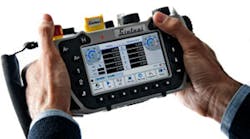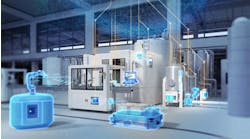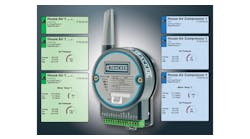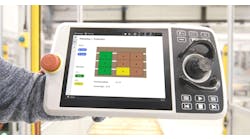Even experienced engineers are challenged by “mechatronics,” the interdisciplinary science that coordinates the practical implications of mechanical design, electronics, computer engineering, control technology, and systems engineering. Challenging or not, the implications of mechatronics are borne out in every factory and machine or fabrication shop.
An obvious challenge for machine shops is to control and operate machines or robots within tight product schedules, amid complex operations and interactions, as well as operations that involve large and/or difficult-to-access systems. Using wireless terminals that provide superior handling and efficiency compared to the wired versions has been impossible due to the lack of terminals with certified safety functions.
Sintesi, an Italian specialist in mechatronics for robotics and automation, has developed a wireless handheld terminal called Shd that allows operators to overcome these limits to make machine tools control and management much simpler.
The Shd terminal is available in wired and wireless versions for industrial machine tools and robots. The wireless terminal is certified by TUV for SIL2 (EN62061) / PLd (ISO13849-1) safety standards. It is the lightest and most compact control terminal available, according to the developer; the design earned the IF Product Design Award 2011 for its design quality, ergonomic features, functions, and its innovation.
Safety features and functionalities
The Shd terminal is designed to have the most advanced ergonomic features, lightweight at 750 grams, with compact dimensions of 22 ×11×4.6 cm, and a wide 5-in. touch screen. With its advanced functions it offers value-adding advantages both to machine tools builders and operators.
The terminal is a hardware platform that integrates software and controls for different types of machines and robots, which has management and cost-saving advantages. Machine builders gain the ability to customize the terminal as well as to develop a range of additional services for customers by connecting the device to the controller already installed to the machine.
Meanwhile, being compact, light and wireless, the Shd terminal provides an important advantage for operators whose free movement is constrained by heavy weights and hazardous cables. Particularly with the wireless version, operators gain 7 to 8 hours of wireless autonomy at up to 50 meters from the machine, via Bluetooth®, assuring the highest levels of safety for all operations. Both wired and wireless versions of the terminal are TUV-certified to SIL2 (EN62061) / PLd (ISO13849-1) safety standards.
The terminal has a soft-touch keyboard and a 5-in. color touch screen, so navigation is clear and intuitive. The interface software, which is fully customizable, allows flexible adaption to specific requirements of each production process.
Secure wireless communication
The wireless version of the Shd terminal is equipped with coupling tokens that allow the single terminal to connect univocally to the machine to be controlled. These coupling tokens not only assure secured connection but also allow many machines to be controlled on one local network without interference.
In particular, the coupling tokens have unique IDs that associate with each other prior to the machining process, providing unique pairing between a terminal and its corresponding CIS. The coupling tokens, together with the emergency stop button, enabling device, and state selector, provide maximum security level even in difficult working conditions.
The terminal can be supplied with a freely programmable HMI and an open protocol to be connected to commercial controllers. Currently, an interface for Siemens PLC/CNC is available, while Fanuc and Rockwell interface will be released soon. This flexibility allows the machine and robot manufacturers to customize the control terminal to offer additional services to their customers, and at the same time supplying their customers with a unique HMI even when their machines use different controllers.






